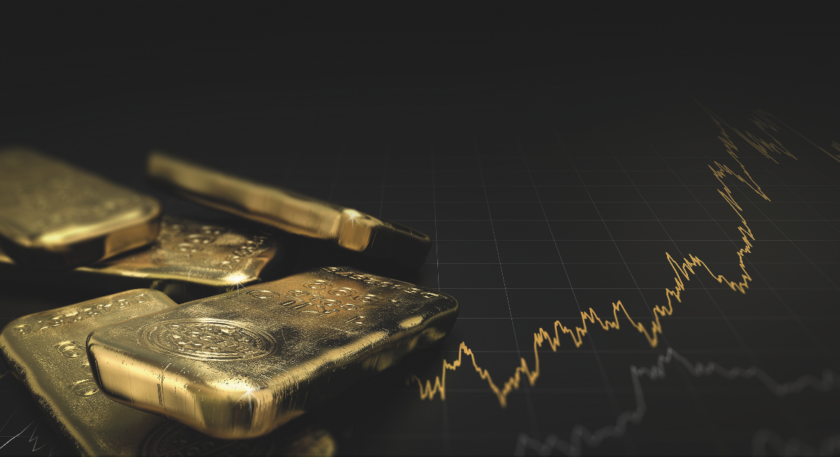Gold may be a popular asset in a crisis but, asks Darius McDermott, managing director, FundCalibre, can it really be a long-term investment from this point onwards?
This article was first published in the November 2020 issue of Professional Paraplanner.
“There is no honest man — not one — that can resist the attraction of gold!” The words of comic playwright and writer Aristophanes are some 2,500 years old but are as true today as they have ever been.
Gold is typically the place to be going into a crisis, due to its defensive qualities and lack of correlation to equities and bonds. The shock seen by markets in February and March proved no exception, as a falling US dollar and a drop in real yields – meaning they could lose money on government bonds and even cash over time – put investors in an unenviable position.
The World Gold Council reported record flows into gold-backed ETFs of 734 tonnes in the first six months of 2020*, fuelled by rate cuts and liquidity injections by central governments. The precious metal subsequently hit $2,000 an ounce for the first time in early August and, as of writing, is around $1,900**.
The detractors would point out the easy money has been made, raising questions for an asset class which does not yield anything. In normal times this would be the case – but these are not normal times – for example, that same economic stimulus from central banks across the globe has not triggered inflation, as it would usually do, supporting the argument for gold. One global investment bank has gone as far as predicting it could rise as high as $3,000 an ounce as early as 2022.
The longer-term picture?
Gold has been one of – if not the biggest – topic for discussion in our team meetings in 2020. The big question obviously being whether we are entering bubble territory or not?
For us, gold still holds value given the huge amount of uncertainty in the marketplace – particularly as we see unemployment rise as furlough schemes across the world come to an end. Only recently, the US announced it was creating 600,000 jobs, but it was expecting to create 800,000, so there’s no guarantee of an economic recovery any time soon. I’d go as far as to say the global economy is very much on the back foot, with many measures designed as short term fixes to get money into the system. There also remains no visibility on a potential vaccine – the light at the end of the tunnel most people are hoping for.
We also expect a different world when we do get through this. For example, the travel and hospitality industries are likely to suffer for many years to come. That environment makes holding gold all the more attractive for the longer-term. That said, when you’ve made a profit of around 50% in three months, it does makes sense to take some money off the table – which we have done.
Rathbone Strategic Growth Portfolio manager David Coombs is of a similar view, having trimmed his allocation as the gold price went towards $2,000 an ounce. David maintains it still has an important place in his portfolio, particularly in this continued environment of low and/or negative bond yields. He says negative interest rates on various bonds mean you’re actually paying some governments to lend them money and that by selling these negative yielding bonds to buy gold, in a way you are increasing your income.
Merian Gold & Silver fund manager Ned Naylor-Leyland believes there is a higher chance of gold reaching $3,000 an ounce than people realise, pointing to the fact that it is not only about gold rising, but sterling falling – with fears about its future purchasing power. He believes that we are now in the midst of a big trend of people becoming fearful of owning cash and bonds.
Ninety One Global Gold manager George Cheveley also says gold prices are well supported and may well continue to move higher over time. He says the US Federal Reserve wants to keep real interest rates low to aid recovery adding that, with base rates already very low, inflation will need to rise. He also feels further pressure on the US dollar could see many emerging market economies increase their efforts to diversify their reserves away from US dollar holdings, particularly China, which may seek to stockpile commodities amid its trade war with the US***.
George says gold stocks are pricing in gold at around $1,800 an ounce; and if the gold price remains in its current range, he expects further gains for the shares of gold companies – adding that they are in the best state they’ve been in for two decades***
I’d personally be surprised if the gold price doubled from here, but the fundamentals do look very strong for some further upside. It’s main traits of diversification, a store of wealth, and an inflation hedge still hold true and this combination makes a holding in gold a prudent choice in an uncertain future.
*Source: World Gold Council
**Source: Gold.co.uk, 5 October 2020
***Source: Fund factsheet, 31 August 2020
Past performance is not a reliable guide to future returns. You may not get back the amount originally invested, and tax rules can change over time. Darius’s views are his own and do not constitute financial advice.



































